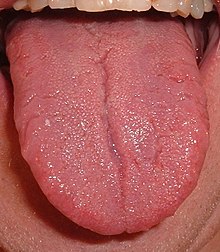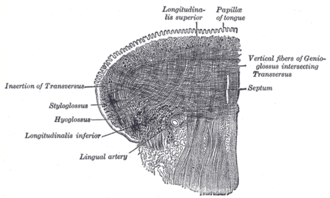Tongue
![]()
The title of this article is ambiguous. For other meanings, see Tongue (disambiguation).
The tongue (Old High German zunga, Latin lingua, Ancient Greek γλῶσσα glōssa (Ionian γλάσσα glassa, Attic γλῶττα glōtta)) is an elongated muscular body (consisting of nine separate muscles) in humans as well as most other vertebrates, covered by mucous membrane, which lies on the floor of the oral cavity and almost completely fills it when the jaws are closed.
It participates in chewing, sucking and swallowing and is equipped with sensory organs for tasting and touching. The human tongue is also an important component of language formation, from which the term linguistics is derived.

Drawing of the anterior view of the tongue and the oral cavity (for better clarity the cheeks are not shown)

Tongue of the human being. The picture shows a special finding, namely a folded tongue (lingua plicata).
Structure
The tongue is divided into the tip (apex linguae), the body (corpus linguae) and the root (radix linguae). The upper surface of the tongue (the dorsum of the tongue, dorsum linguae) is somewhat convex, lies entirely exposed, and shows at the back a triangular depression, the blind hole, in which several mucous glands open. In phonetics, the anterior, mobile part of the dorsum of the tongue directly behind the tip of the tongue, which is involved in sound formation, is called the tongue blade. In the area of the tip of the tongue, a small salivary gland, the lingual tip gland (glandula lingualis anterior, Blandin-Nuhn gland), is located under the mucous membrane. In the rear area of the tongue, further salivary glands, the lingual glands (glandulae linguales), are located.
The lower surface is attached to the floor of the oral cavity with its central part and is attached at the front by a fold of the oral mucosa, the lingual frenulum (frenulum linguae), in such a way that only the tip of the tongue (apex linguae) and the lateral edges are free. If the lingual frenulum extends too far forward, the free movement of the tongue is impaired (ankyloglosson). This can impair sucking and sound production. This developmental disorder can be eliminated by an incision in the lingual frenulum (tongue loosening).
The rearmost, thickest part of the tongue, the root of the tongue (radix linguae), is attached to the hyoid bone, which lies in the upper part of the neck and is connected to the larynx again by muscles and ligaments.
In the midline of the tongue is a kind of vertical septum, the septum linguae. In all other respects, however, the tongue consists mainly of muscle fibres with numerous nerves and blood vessels running between them. The muscle fibres are arranged in all three spatial directions and thus enable the extremely high mobility of the tongue.
Tongue muscles
→ Main article: Tongue muscles
The tongue musculature is divided morphologically but also functionally-motorically into an inner tongue musculature - it runs entirely inside the tongue body - and an outer tongue musculature. The latter connects the tongue with the surrounding organ and tissue structures.
The internal muscles of the tongue (abbreviation M. corresponds to musculus) include the:
Shortening and widening of the tongue, lifting the tip of the tongue:
- superior longitudinalis
- inferior longitudinal muscle
Lengthening or narrowing of the tongue, sticking out the tip of the tongue:
- transverse lingual muscle
- lingual verticalis
and the external muscles of the tongue include:
Pull the tongue down in front (ventro-caudal):
- M. genioglossus
Pull the tongue down behind (dorso-caudal):
- M. chondroglossus
Pull the tongue up backwards (dorso-rostral):
- M. styloglossus
Pull the tongue down behind (dorso-caudal):
- M. hyoglossus
Narrowing of the isthmus faucium:
- palatoglossus

Frontal plane of the tongue with the striated internal musculature.

Lateral view of the tongue with the corresponding free-prepared musculature.

Sagittal plane of the human oral cavity, oropharynx and larynopharynx and tongue or tongue musculature. Places of articulation (active and passive) for phonation of spoken language: 1 exolabial (outer part of lip) 2 endolabial (inner part of lip) 3 dental (teeth) 4 alveolar (anterior part of dental arch) 5 postalveolar (posterior part of dental arch and a little behind) 6 prepalatal (anterior part of hard palate) 7 palatal (hard palate) 8 velar (soft palate) 9 uvular (also postvelar; 10 pharyngal (pharynx) 11 glottal (also laryngal; vocal cords) 12 epiglottal (epiglottis) 13 radical (root of tongue) 14 posterodorsal (posterior part of tongue) 15 anterodorsal (anterior part of tongue) 16 laminal (tongue blade) 17 apical (tip of tongue) 18 sublaminal (also subapical; underside of tongue)
Innervation
The tongue is innervated in a very complex way by several nerves:
- The tongue is supplied motorically by the hypoglossal nerve.
- Sensory and sensory innervation occurs in the posterior third of the tongue through the glossopharyngeal nerve.
- The sensory supply of the anterior two-thirds is provided by the lingual nerve.
- The taste stimuli of the anterior two-thirds of the tongue are transmitted by the chorda tympani, a branch of the facial nerve.
Search within the encyclopedia